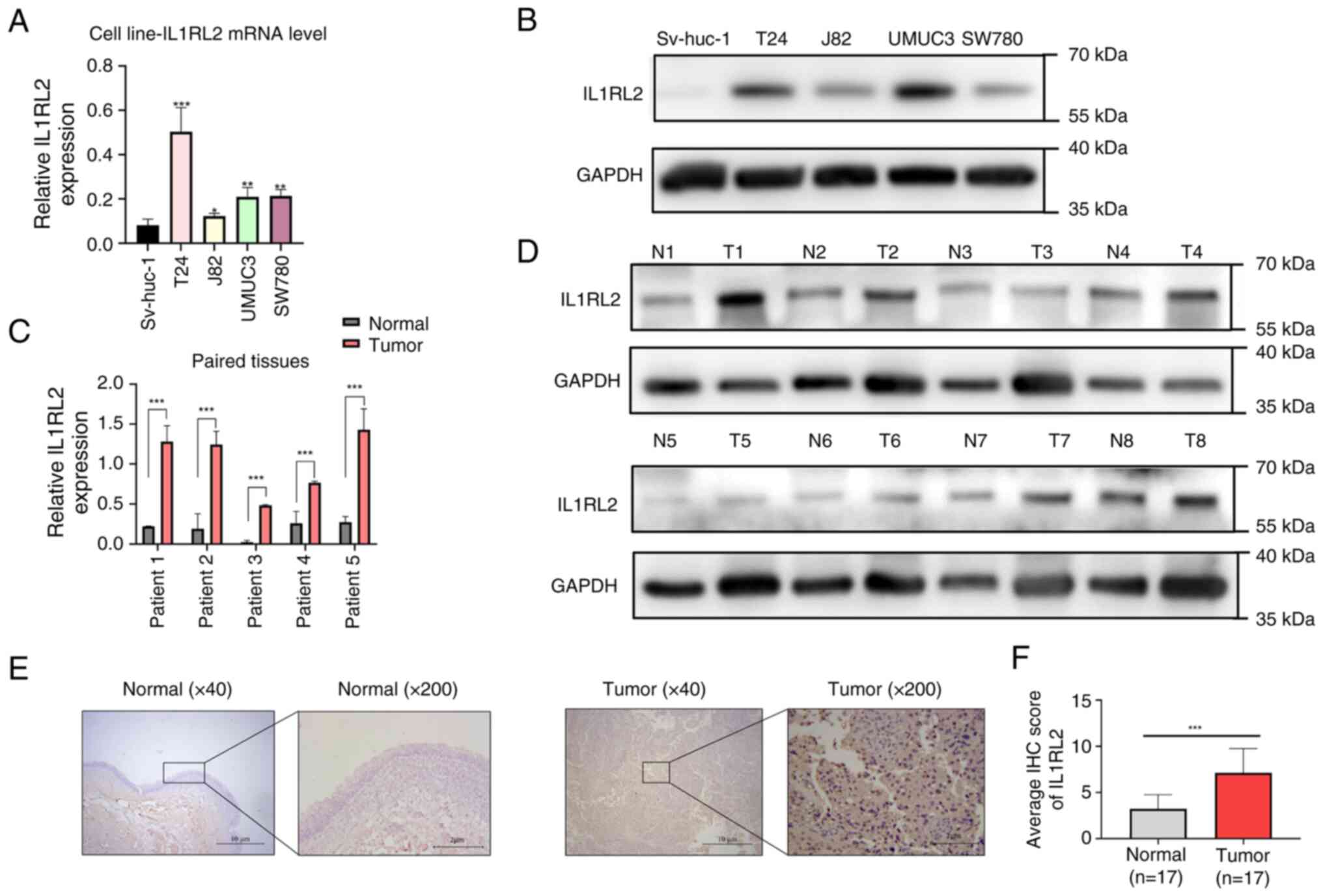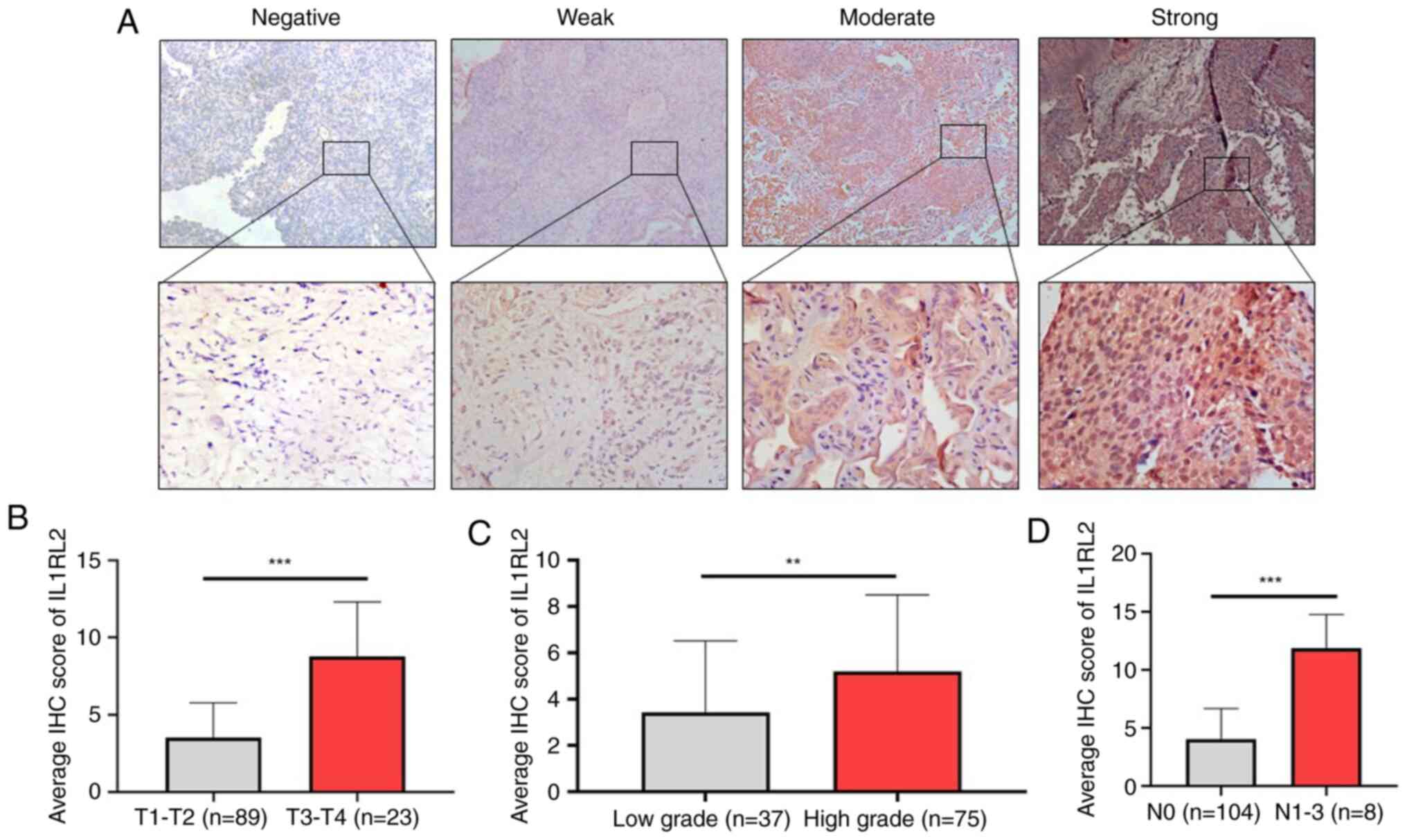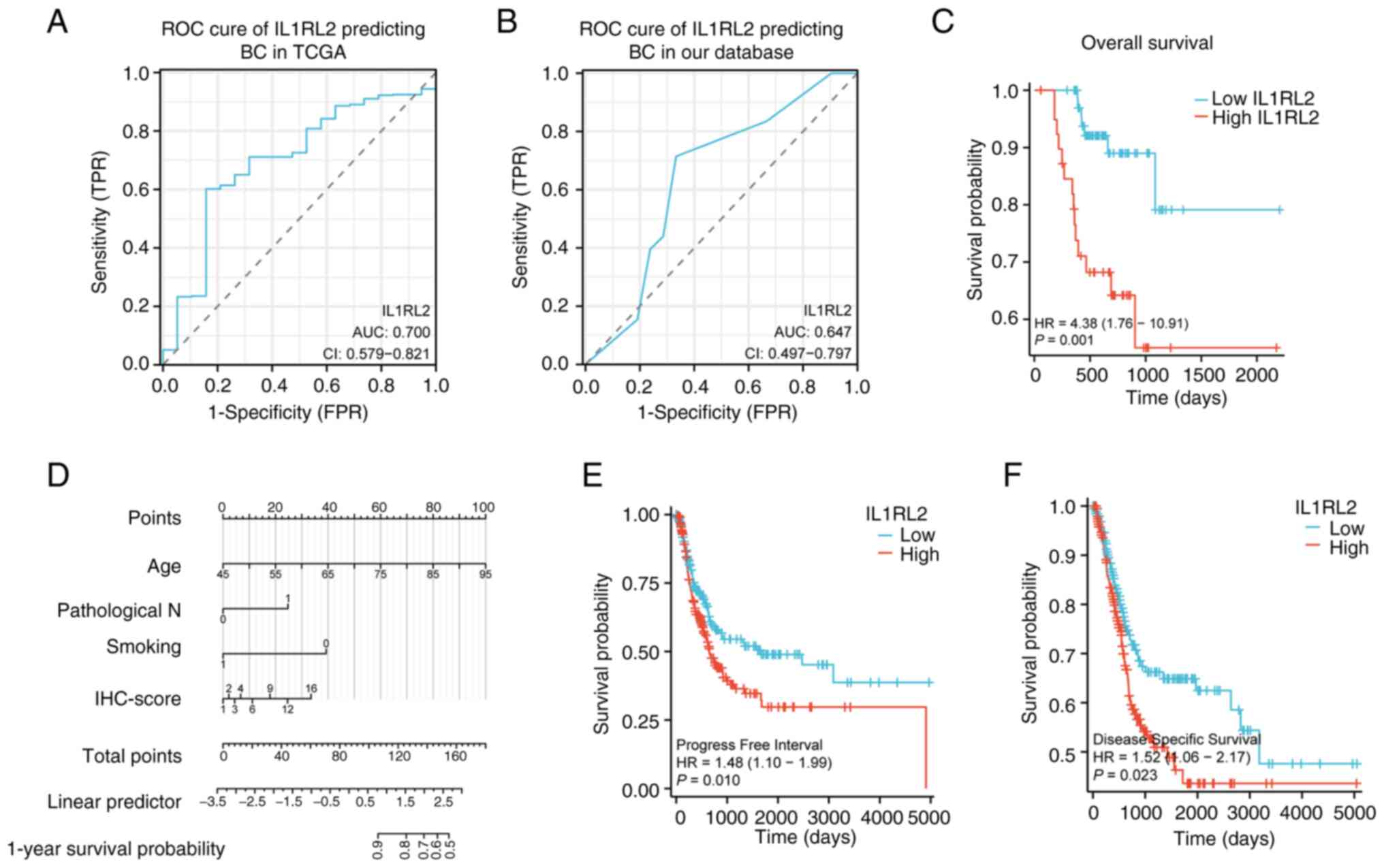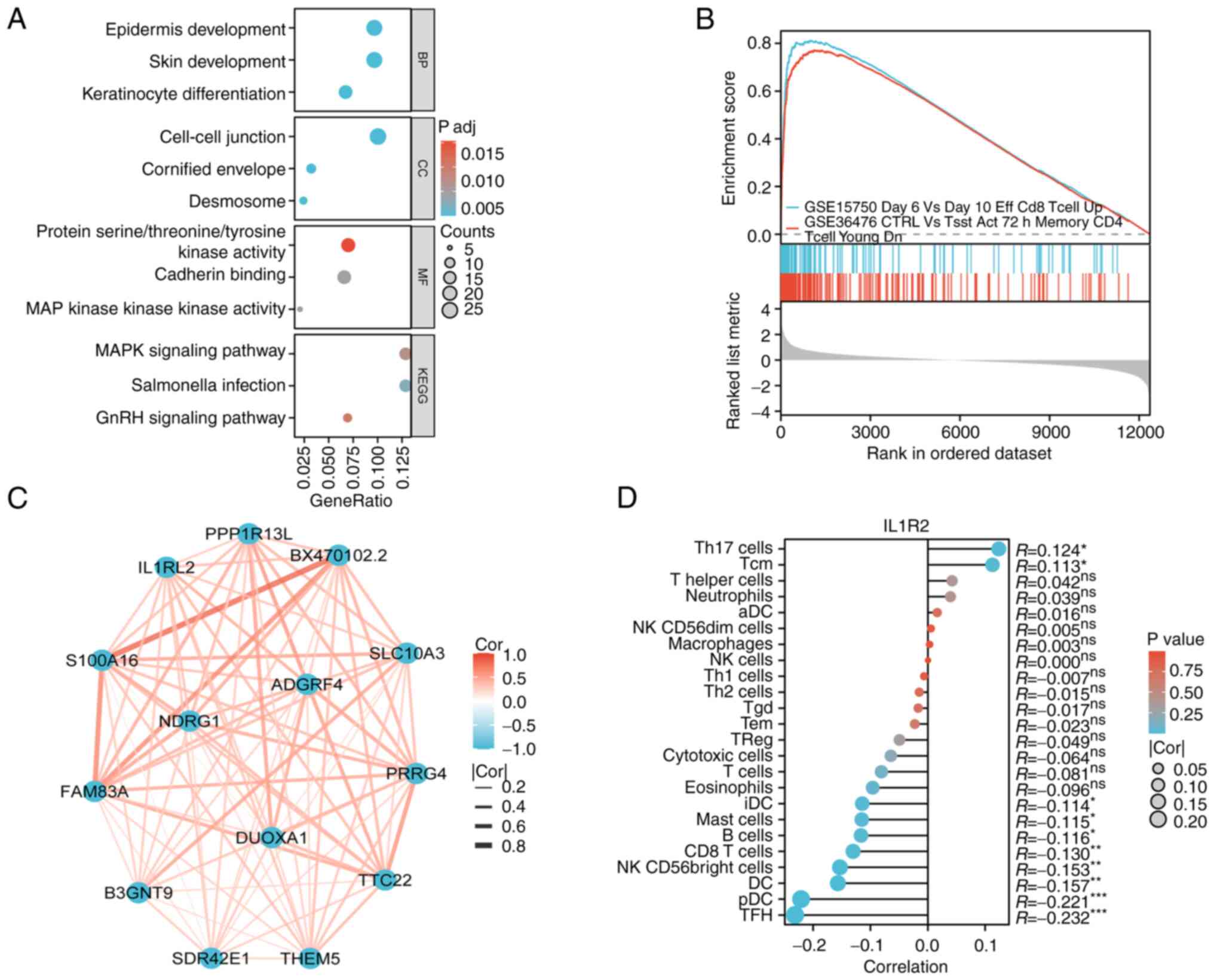IL1RL2 is related to the expression and prognosis of bladder cancer
- Authors:
- Published online on: August 13, 2024 https://doi.org/10.3892/mco.2024.2773
- Article Number: 75
-
Copyright: © Ha et al. This is an open access article distributed under the terms of Creative Commons Attribution License [CC BY_NC 4.0].
Abstract
Introduction
Bladder cancer (BLCA) is the most common malignancy of the genitourinary system in China and ranking tenth worldwide (1-3). BLCA is classified into non-muscular-invasive BLCA (NMIBC) and muscle-invasive BLCA (MIBC). NMIBC, which accounts for 75% of BLCAs, progresses slowly and has a long survival, however it still develops into MIBC in nearly 30% of NMIBC (4,5). Treatment outcomes for MIBC are less favorable, with shorter recurrence-free survival (RFS) and overall survival (OS) (6,7). Early identification of BLCA is closely linked to prognosis. However, patients with early BLCA often do not present with specific symptoms. Therefore, exploring the molecules associated with BLCA is of great importance to monitoring the incidence of BLCA and improving the clinical treatment strategy.
Interleukin 1 receptor-like 2 (IL1RL2), also known as IL36R, is part of the interleukin-1 receptor family. Alongside four other family members interleukin-1 receptor type I, interleukin-1 receptor type II, interleukin-1 receptor-like 1 and interleukin-18 receptor 1-IL1RL2 forms a cluster of cell receptor genes. Research on IL36R primarily focuses on its crucial role as a mediator of inflammatory responses. The three receptor agonists, IL-36α, IL-36β and IL-36γ, bind to the IL-36R complex and exert pleiotropic effects, particularly in the context of inflammatory bowel diseases (8-11). The established interaction between inflammation and cancer recognizes chronic inflammation as a hallmark of cancer (12). High expression of IL1RL2 has been observed in colorectal cancer, demonstrating a pro-metastatic effect and association with patient prognosis (13). IL1RL2 has also been revealed to play a regulatory role in breast, gastric and lung cancer (14-16). However, the relationship between IL1RL2 and BLCA is less understood. Thus, the objective of the present study was to assess the prognostic significance of IL1RL2 in BLCA and investigate its correlation with clinical pathological features of the disease.
Materials and methods
Clinical specimens
A total of eight pairs of BLCA tissues and adjacent non-cancerous tissues from Peking University First Hospital-Miyun Hospital were collected between January 2018 and January 2023 (Beijing, China). Each pair of bladder tissue and adjacent non-cancerous tissue came from the same patient. Additionally, 17 pairs of BLCA and adjacent non-cancerous tissues, along with 112 paraffin-embedded BLCA tissue blocks at various stages, were gathered. Data from 112 patients with bladder cancer were incorporated into the Miyun cohort. All patients were pathologically diagnosed with urothelial carcinoma, and the histological characteristics of the samples were confirmed by experienced urological pathologists using hematoxylin-eosin staining. The present study was approved (approval no. 2023-029-001) by the Medical Ethics Committee of Peking University First Hospital-Miyun Hospital (Beijing, China). Clinicopathological characteristics of patients (including sex and age distribution) are listed in Table I.
In silico analysis of IL1RL2 using online datasets
Transcriptome and clinical data from the The Cancer Genome Atlas (TCGA)-BLCA datasets, encompassing 410 patients with bladder carcinoma, were downloaded from UCSC XENA (https://xena.ucsc.edu/) (17). The Xiantao tool (https://www.xiantao.love/) was used for visualization and analysis of expression differences, prognosis and enrichment (18).
Cell culture
Human ureteral epithelial cells (SV-HUC-1) and human BLCA cell lines (T24, J82, UMUC3 and SW780) were obtained from the American Type Culture Collection and cultured according to the manufacturer's protocols. SV-HUC-1 cells were maintained in F-12K medium (Gibco; Thermo Fisher Scientific, Inc.), while T24, J82, UMUC3 and SW780 cells were cultured in RPMI-1640 medium (Gibco; Thermo Fisher Scientific, Inc.). All media were supplemented with 10% fetal bovine serum (Gibco; Thermo Fisher Scientific, Inc.) and 1% penicillin G-streptomycin (Sigma-Aldrich; Merck KGaA). Cultures were kept at 37˚C with 5% CO2.
Reverse transcription-quantitative (RT-q) PCR
RNA was extracted from cells using TRIzol® reagent (Invitrogen; Thermo Fisher Scientific, Inc.). cDNA synthesis was performed using a reverse transcription system (Tiangen Biotech Co., Ltd.) following the manufacturer's protocol (42˚C for 15 min, 95˚C for 3 min, 4˚C maintenance). RT-qPCR was conducted on the 7500 Reverse transcription PCR System (Applied Biosystems; Thermo Fisher Scientific, Inc.), with GAPDH as the internal reference. The thermocycling conditions were as follows: pre-denaturation at 95˚C for 3 min, denaturation at 95˚C for 30 sec, annealing extension at 60˚C for 30 sec, deformation and annealing extension for 40 cycles. The dissolution curve was increased by 0.5˚C every 2 cycles to 95˚C. The primer sequences were as follows: IL1RL2 forward, 5'-TCCCGAAGAGTTGTGTTTTGG-3, and reverse, 5'-TGAGTGTGTCAGTATGGCTTGA-3'; and GAPDH forward, 5'-GGAGCGAGATCCCTCCAAAAT-3, and reverse, 5'-GGCTGTTGTCATACTTCTCATGG-3'. The 2-ΔΔCq method was used for quantification (19).
Western blotting
The primary antibody was incubated at 4˚C overnight, and the secondary antibody was incubated at room temperature for 1 h. Total protein was extracted using NP-40 lysis buffer (Beyotime Institute of Biotechnology) and quantified by the BCA method (Pierce; Thermo Fisher Scientific, Inc.). Proteins were separated by SDS-PAGE (10% gel concentration) and transferred to PVDF membranes. After blocking with 5% skimmed milk for 1 h at room temperature, membranes were incubated with IL1RL2/IL36R antibody (1:1,000; cat. no. 10090; ABclonal Biotech Co., Ltd.) followed by a horseradish peroxidase-conjugated anti-rabbit secondary antibody (1:2,000; cat. no. sc-2004/sc-2005; Santa Cruz Biotechnology, Inc.). GAPDH (1:1,000; cat. no. sc-47724; Santa Cruz Biotechnology, Inc.) served as the internal reference. Immunoreactive bands were visualized using the ECL Plus kit (Applygen Technologies Inc.).
Immunohistochemistry (IHC)
Paraffin samples were sliced to a thickness of 5 µm. All paraffin samples were cut by the same pathologist and were of similar thickness. IHC staining was performed using the PV-6000 universal kit (cat. no. IB000088; ZSGB-BIO; OriGene Technologies, Inc.). Sections were heated at 70˚C for 1 h, deparaffinized in xylene and rehydrated (95% anhydrous ethanol), followed by antigen retrieval with citrate repair solution at 110˚C for 10 min. Slides were incubated at room temperature for 20 min away from light) with endogenous peroxidase inhibitor blocking agent and sheep serum (cat. no. ZU-9022). IL1RL2/IL36R antibody (1:500; cat. no. 10090; ABclonal Biotech Co., Ltd.) was applied (incubated overnight at 4˚C in the dark), followed by incubation with a biotinylated secondary antibody (cat. no. 32020; Thermo Fisher Scientific, Inc.; room temperature for 20 min away from light) and staining with the DAB substrate kit (cat. no. ZU-9019; ZSGB-BIO; OriGene Technologies, Inc.). When the background of the slide was brown, reaction was terminated in tap water. Blue was reversed in running tap water for 30 min. Then gradient dehydration with ethanol and xylene was carried out. Finally, it was sealed with neutral resin. IL1RL2 expression was graded based on staining intensity (1, no staining; 2, weak; 3, moderate; 4, strong) and the percentage of reactive cells (1, 0-25%; 2, 26-50%; 3, 51-75%; 4, >75%). The final score (range 1-16) was the product of these variables. The degree of dyeing has several intermediate stages, and the pink brown is also one of them, representing the degree of dyeing. Images were observed using a light microscope.
Statistical analysis
Data were analyzed using GraphPad Prism 9.0 (Dotmatics) or SPSS 20.0 (IBM). Results are expressed as the mean ± SD. Continuous variables were compared using paired and unpaired Student's t-test or one-way ANOVA followed by Bonferroni's post hoc test (for multiple-group comparison) single factor analysis. Pearson's chi-square test or Fisher's exact test were used for correlation analysis. Survival rates were analyzed using the Kaplan-Meier method and log-rank P-tests. Prognostic correlations between clinicopathological and IHC data were assessed by univariate and multivariate Cox regression analyses. *P<0.05 was considered to indicate a statistically significant difference.
Results
Il1RL2 is upregulated in BLCA and associated with tumor stage
To investigate the expression of IL1RL2 in BLCA, IL1RL2 mRNA expression was examined using data from the TCGA database. As illustrated in Fig. 1A, IL1RL2 expression in BLCA tissues from TCGA was significantly elevated compared with normal tissues. Data from TCGA indicated upregulated expression of IL1RL2 mRNA in high-stage and high-grade BLCA tissues (Fig. 1B and C). Additionally, IL1RL2 mRNA was also highly expressed in patients with BLCA and lymph node metastasis (Fig. 1D).
IL1RL2 demonstrates elevated expression in both BLCA cell lines and tissues
RT-qPCR was employed to assess IL1RL2 mRNA levels specifically in BLCA cell lines. The results revealed higher IL1RL2 mRNA expression in the tumor cell lines compared with SV-HUC-1 cells, as depicted in Fig. 2A. Meanwhile, the mRNA expression level of IL1RL2 in BLCA tissues was higher than that in adjacent normal tissues (Fig. 2C). Furthermore, western blot analysis demonstrated an upregulation of IL1RL2 protein expression in both BLCA cell lines (Fig. 2B) and tissues (Fig. 2D). To further understand the IL1RL2 presence in BLCA tissues, IHC was performed on 17 pairs of BLCA tissues and adjacent normal tissues. The results revealed that IL1RL2 was highly expressed in BLCA tissues compared with adjacent normal tissues (Fig. 2E and F).
IL1RL2 is highly expressed in high-stage and high-grade BLCA
IHC scoring based on different staining intensities (Fig. 3A) and areas was performed. The average IHC score of IL1RL2 expression in patients with high-stage and high-grade BLCA was significantly higher than in low-stage (P<0.001; Fig. 3B) and low-grade BLCA (P<0.01; Fig. 3C; Table I). Patients with BLCA with lymph node metastasis demonstrated a significantly higher average IHC score of IL1RL2 expression compared with non-metastatic patients (P<0.001; Fig. 3D).
High IL1RL2 expression is associated with improved OS in patients with BLCA
To evaluate the diagnostic potential of IL1RL2, the differential expression in BLCA vs. adjacent normal tissues was analyzed, generating receiver operator characteristic (ROC) curves using data from the TCGA database and a cohort of 112 patients with BLCA. The ROC curves revealed that IL1RL2 expression distinguished tumors from adjacent normal tissues with an AUC of 0.700 (95% CI: 0.579-0.821) in TCGA and 0.647 (95% CI: 0.497-0.797) in Miyun chart database (Fig. 4A and B). IHC analysis of 112 patients with BLCA at different stages and grades revealed a correlation between OS time and IL1RL2 expression (Fig. 4C). For OS analysis, in univariate analysis, IL1RL2 expression was negatively correlated with OS (95% CI: 0.072-0.552; P=0.002); and smoking (95% CI: 1.091-22.834; P=0.038), age (95% CI: 1.035-1.175; P=0.003) and lymph node metastasis (95% CI: 0.024-0.502; P=0.004) were also factors influencing OS (Table II). In multivariate analysis, smoking (95% CI: 1.024-28.661; P=0.047), age (95% CI: 1.028-1.190; P=0.007) and IL1RL2 expression (95% CI: 0.089-0.988; P=0.048) were associated with poorer OS. A line chart predicting survival was constructed based on smoking, age and IL1RL2 (Fig. 4D). For RFS analysis, in univariate analysis, sex (95% CI: 0.116-0.939; P=0.038) and pathological stage (95% CI: 0.136-0.989; P=0.047) were factors influencing RFS, while IL1RL2 was not a factor for RFS (Table SI). In multivariate analysis, sex (95% CI: 0.332 (0.116-0.949; P=0.0039) was associated with poorer RFS, suggesting that sex may be an independent prognostic factor for patients with BLCA. In TCGA database, High levels of IL1RL2 expression were associated with lower disease-specific survival and progression-free survival (Fig. 4E and F).
Table IIUnivariate analysis and multivariate analysis of overall survival of bladder cancer in Miyun chart database. |
To explore the functional implications of IL1RL2 in BLCA, enrichment analysis of Gene Ontology (GO) terms and Kyoto Encyclopedia of Genes and Genomes (KEGG) pathways were performed using genes co-expressed with IL1RL2 obtained from the TCGA BLCA database. This analysis aimed to uncover the biological roles associated with IL1RL2 in BLCA. In GO enrichment analysis, cell-cell junction, epidermis development and MAP kinase activity were enriched (Fig. 5A). KEGG enrichment highlighted MAPK signaling pathway and Salmonella infection (Fig. 5A). Additionally, Gene Set Enrichment Analysis (GSEA) in BLCA indicated that elevated IL1RL2 expression was linked to several critical processes that promote tumorigenesis, including tumor immune infiltration-related processes such as CD8 T cells and memory CD4 (Fig. 5B), suggesting that IL1RL2 may facilitate bladder tumor development. Protein-protein interaction analysis revealed that potential targets of IL1RL2 were primarily genes associated with cell proliferation and migration (Fig. 5C). Immuno-infiltration analysis of IL1RL2 in BLCA revealed potential associations with plasmacytoid dendritic cells (pDC) and T follicular helper cells (TFH) (Fig. 5D). Overall, these results suggested that IL1RL2 may regulate tumor development through modulation of the tumor immune microenvironment and MAPK signaling pathway.
Discussion
BLCA is a common malignancy with a high recurrence rate and potential for metastasis (20). Despite continuous advancements in medical care over the past decades, there has been limited improvement in the treatment outcomes and diagnostic methods for BLCA (21). Identifying specific genes expressed at the molecular level in BLCA could contribute to its diagnosis and treatment. Currently, there is no reported research on the role of IL1RL2 in BLCA. The present study revealed that IL1RL2 is upregulated in BLCA and correlated with the stage, grade, lymph node album and prognosis of BLCA.
Early diagnosis and monitoring of BLCA are crucial for improving patient prognosis. Numerous diagnostic biomarkers have been identified in previous studies. Lokeshwar et al (22) found that BTA testing has high sensitivity and specificity in patients with BLCA. Additionally, Grossman et al (23) demonstrated that NMP22 testing can effectively distinguish patients with BLCA from healthy individuals. However, current diagnostic methods are still limited, and there is a need to improve both sensitivity and specificity.
IL1RL2 has been identified as a novel diagnostic and prognostic marker in various cancer types, such as breast, gastric, colorectal and lung cancer, suggesting its potential as both a diagnostic marker and therapeutic target (19,24-27). Baker et al (27) found that IL1RL2 agonists promote the progression of human and murine lung cancer, leading to tumor cell proliferation and migration. The team also discovered high expression of IL1RL2 in colorectal cancer, with a concurrent role in promoting colorectal cancer metastasis (13). These results suggested that IL1RL2 plays a crucial role in tumorigenesis and development.
In the present study, through analysis of TCGA and 112 samples of patients with BLCA database, the abundance of IL1RL2 in BLCA and its clinical significance were explored and confirmed. The results indicated that IL1RL2 is upregulated in both BLCA tissues and cells. The IL1RL2 level is significantly correlated with tumor stage, grade and metastasis. Furthermore, IHC analysis revealed that IL1RL2 expression is an independent risk factor for OS. Additionally, Kaplan-Meier survival analysis using TCGA and 112 patients with BLCA from Miyun chart database revealed that upregulated IL1RL2 status is associated with lower disease-specific survival and progression-free interval rates. These data suggested that IL1RL2 is associated with BLCA survival and tumor progression.
To further analyze the oncogenic role of IL1RL2 in BLCA, a bioinformatics analysis was performed for functional prediction. Enrichment analysis suggested that IL1RL2 may participate in the MAPK signaling pathway, a pathway crucial for tumor proliferation, migration and invasion (28-30). GSEA enrichment revealed the enrichment of immune cells, such as CD4 and CD8, indicating that IL1RL2 may regulate tumor progression through modulation of the tumor immune microenvironment. Immuno-infiltration analysis of IL1RL2 in BLCA suggested potential associations with pDC and TFH.
While the present study has identified the expression profile of IL1RL2 in BLCA, the oncogenic functions of IL1RL2 in BLCA need further clarification both in vitro and in vivo. Additionally, the specific molecular mechanisms through which IL1RL2 operates require further exploration. IL1RL2 has the potential to serve as a molecular marker for the assessment of BLCA prognosis and help clinicians develop more individualized treatment strategies. The present study provided new ideas and potential molecular targets for the early diagnosis, prognosis assessment and individualized treatment of BLCA.
Supplementary Material
Univariate analysis and multivariate analysis of recurrence-free survival of bladder cancer in our database.
Acknowledgements
Not applicable.
Funding
Funding: No funding was received.
Availability of data and materials
The data generated in the present study may be requested from the corresponding author.
Authors' contributions
XH, YL, LS and WG conceptualized and designed the present study. LS and WG provided administrative support. XH, YL, ZG, JC, YN, LS, WG provided the study materials or recruited patients. WG collected and assembled the data. XH and YL analyzed and interpreted the data. XH and YL confirm the authenticity of all the raw data. All authors contributed to manuscript writing, and read and approved the final version of the manuscript.
Ethics approval and consent to participate
The present study was conducted in accordance with the Declaration of Helsinki (as revised in 2013) and was approved (approval no. 2023-029-001) by the Ethics Committee of Peking University First Hospital-Miyun Hospital (Beijing, China).
Patient consent for publication
Not applicable.
Competing interests
The authors declare that they have no competing interests.
References
|
Sung H, Ferlay J, Siegel RL, Laversanne M, Soerjomataram I, Jemal A and Bray F: Global cancer statistics 2020: Globocan estimates of incidence and mortality worldwide for 36 cancers in 185 countries. CA Cancer J Clin. 71:209–249. 2021.PubMed/NCBI View Article : Google Scholar | |
|
Li K and Lin T: Chinese Bladder Cancer Consortium. Xue W, Mu X, Xu E, Yang X, Chen F, Li G, Ma L, et al: Current status of diagnosis and treatment of bladder cancer in China-analyses of Chinese bladder cancer consortium database. Asian J Urol. 2:63–69. 2015.PubMed/NCBI View Article : Google Scholar | |
|
Lobo N, Afferi L, Moschini M, Mostafid H, Porten S, Psutka SP, Gupta S, Smith AB, Williams SB and Lotan Y: Epidemiology, screening, and prevention of bladder cancer. Eur Urol Oncol. 5:628–639. 2022.PubMed/NCBI View Article : Google Scholar | |
|
Chen H, Yang W, Xue X, Li Y, Jin Z and Ji Z: Integrated analysis revealed an inflammatory cancer-associated fibroblast-based subtypes with promising implications in predicting the prognosis and immunotherapeutic response of bladder cancer patients. Int J Mol Sci. 23(15970)2022.PubMed/NCBI View Article : Google Scholar | |
|
Babjuk M, Burger M, Capoun O, Cohen D, Compérat EM, Dominguez Escrig JL, Gontero P, Liedberg F, Masson-Lecomte A, Mostafid AH, et al: European association of urology guidelines on non-muscle-invasive bladder cancer (Ta, T1, and carcinoma in situ). Eur Urol. 81:75–94. 2022.PubMed/NCBI View Article : Google Scholar | |
|
Stein JP and Skinner DG: Radical cystectomy for invasive bladder cancer: Long-term results of a standard procedure. World J Urol. 24:296–304. 2006.PubMed/NCBI View Article : Google Scholar | |
|
Witjes JA, Bruins HM, Cathomas R, Compérat EM, Cowan NC, Gakis G, Hernández V, Linares Espinós E, Lorch A, Neuzillet Y, et al: European association of urology guidelines on muscle-invasive and metastatic bladder cancer: Summary of the 2020 guidelines. Eur Urol. 79:82–104. 2021.PubMed/NCBI View Article : Google Scholar | |
|
Dale M and Nicklin MJ: Interleukin-1 receptor cluster: Gene organization of IL1R2, IL1R1, IL1RL2 (IL-1Rrp2), IL1RL1 (T1/ST2), and IL18R1 (IL-1Rrp) on human chromosome 2q. Genomics. 57:177–179. 1999.PubMed/NCBI View Article : Google Scholar | |
|
Ngo VL, Kuczma M, Maxim E and Denning TL: Il-36 cytokines and gut immunity. Immunology. 163:145–154. 2021.PubMed/NCBI View Article : Google Scholar | |
|
Tomuschat C, O'Donnell AM, Coyle D and Puri P: Altered expression of IL36γ and IL36 receptor (IL1RL2) in the colon of patients with Hirschsprung's disease. Pediatr Surg Int. 33:181–186. 2017.PubMed/NCBI View Article : Google Scholar | |
|
Scheibe K, Kersten C, Schmied A, Vieth M, Primbs T, Carlé B, Knieling F, Claussen J, Klimowicz AC, Zheng J, et al: Inhibiting interleukin 36 receptor signaling reduces fibrosis in mice with chronic intestinal inflammation. Gastroenterology. 156:1082–1097.e11. 2019.PubMed/NCBI View Article : Google Scholar | |
|
Hanahan D and Weinberg RA: Hallmarks of cancer: The next generation. Cell. 144:646–674. 2011.PubMed/NCBI View Article : Google Scholar | |
|
Baker KJ, Brint E and Houston A: Transcriptomic and functional analyses reveal a tumour-promoting role for the IL-36 receptor in colon cancer and crosstalk between IL-36 signalling and the IL-17/IL-23 axis. Br J Cancer. 128:735–747. 2023.PubMed/NCBI View Article : Google Scholar | |
|
Poudel M, Bhattarai PY, Shrestha P and Choi HS: Regulation of interleukin-36γ/IL-36R signaling axis by PIN1 in epithelial cell transformation and breast tumorigenesis. Cancers (Basel). 14(3654)2022.PubMed/NCBI View Article : Google Scholar | |
|
Wang P, Yang W, Guo H, Dong HP, Guo YY, Gan H, Wang Z, Cheng Y, Deng Y, Xie S, et al: IL-36γ and IL-36Ra reciprocally regulate NSCLC progression by modulating GSH homeostasis and oxidative stress-induced cell death. Adv Sci (Weinh). 8(e2101501)2021.PubMed/NCBI View Article : Google Scholar | |
|
Kovach MA, Che K, Brundin B, Andersson A, Asgeirsdottir H, Padra M, Lindén SK, Qvarfordt I, Newstead MW, Standiford TJ and Lindén A: IL-36 cytokines promote inflammation in the lungs of long-term smokers. Am J Respir Cell Mol Biol. 64:173–182. 2021.PubMed/NCBI View Article : Google Scholar | |
|
Goldman MJ, Craft B, Hastie M, Repečka K, McDade F, Kamath A, Banerjee A, Luo Y, Rogers D, Brooks AN, et al: Visualizing and interpreting cancer genomics data via the Xena platform. Nat Biotechnol. 38:675–678. 2020.PubMed/NCBI View Article : Google Scholar | |
|
Guo Q, Zhao L, Yan N, Li Y, Guo C, Dang S, Shen X, Han J and Luo Y: Integrated pan-cancer analysis and experimental verification of the roles of tropomyosin 4 in gastric cancer. Front Immunol. 14(1148056)2023.PubMed/NCBI View Article : Google Scholar | |
|
Livak KJ and Schmittgen TD: Analysis of relative gene expression data using real-time quantitative PCR and the 2(-Delta Delta C(T)) method. Methods. 25:402–408. 2001.PubMed/NCBI View Article : Google Scholar | |
|
Dyrskjøt L, Hansel DE, Efstathiou JA, Knowles MA, Galsky MD, Teoh J and Theodorescu D: Bladder cancer. Nat Rev Dis Primers. 9(58)2023.PubMed/NCBI View Article : Google Scholar | |
|
Siegel RL, Miller KD, Fuchs HE and Jemal A: Cancer statistics, 2021. CA Cancer J Clin. 71:7–33. 2021.PubMed/NCBI View Article : Google Scholar | |
|
Lokeshwar VB and Soloway MS: Current bladder tumor tests: Does their projected utility fulfill clinical necessity? J Urol. 165:1067–1077. 2001.PubMed/NCBI | |
|
Grossman HB, Messing E, Soloway M, Tomera K, Katz G, Berger Y and Shen Y: Detection of bladder cancer using a point-of-care proteomic assay. JAMA. 293:810–816. 2005.PubMed/NCBI View Article : Google Scholar | |
|
Wen S, He L, Zhong Z, Mi H and Liu F: Prognostic model of colorectal cancer constructed by eight immune-related genes. Front Mol Biosci. 7(604252)2020.PubMed/NCBI View Article : Google Scholar | |
|
Chen YC, Gonzalez ME, Burman B, Zhao X, Anwar T, Tran M, Medhora N, Hiziroglu AB, Lee W, Cheng YH, et al: Mesenchymal stem/stromal cell engulfment reveals metastatic advantage in breast cancer. Cell Rep. 27:3916–3926.e5. 2019.PubMed/NCBI View Article : Google Scholar | |
|
Hao M, Li H, Yi M, Zhu Y, Wang K, Liu Y, Liang X and Ding L: Development of an immune-related gene prognostic risk model and identification of an immune infiltration signature in the tumor microenvironment of colon cancer. BMC Gastroenterol. 23(58)2023.PubMed/NCBI View Article : Google Scholar | |
|
Baker KJ, Buskiewicz E, Finucane M, Chelliah A, Burke L, Houston A and Brint E: IL-36 expression is increased in NSCLC with IL-36 stimulation of lung cancer cells promoting a pro-tumorigenic phenotype. Cytokine. 165(156170)2023.PubMed/NCBI View Article : Google Scholar | |
|
Drosten M and Barbacid M: Targeting the MAPK pathway in KRAS-driven tumors. Cancer Cell. 37:543–550. 2020.PubMed/NCBI View Article : Google Scholar | |
|
Ullah R, Yin Q, Snell AH and Wan L: RAF-MEK-ERK pathway in cancer evolution and treatment. Semin Cancer Biol. 85:123–154. 2022.PubMed/NCBI View Article : Google Scholar | |
|
Lee S, Rauch J and Kolch W: Targeting MAPK signaling in cancer: Mechanisms of drug resistance and sensitivity. Int J Mol Sci. 21(1102)2020.PubMed/NCBI View Article : Google Scholar |















